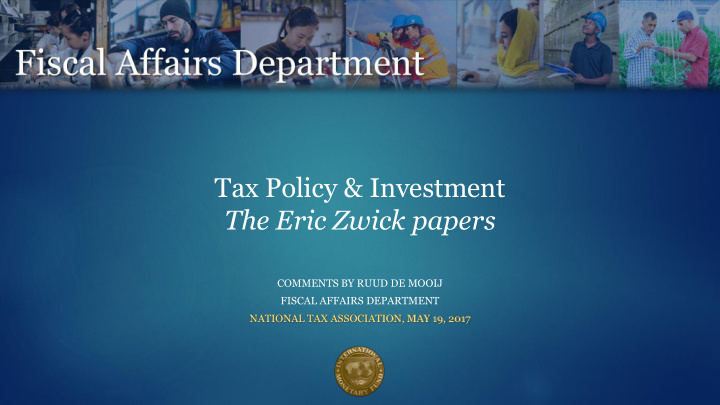



Tax Policy & Investment The Eric Zwick papers COMMENTS BY RUUD DE MOOIJ FISCAL AFFAIRS DEPARTMENT NATIONAL TAX ASSOCIATION, MAY 19, 2017
Distortions From Corporate Tax Policy Income shifting – see Heckemeyer and Overesch 2013 - Domestic (legal form) - PIT versus CIT - International (BEPS) - CIT rate differences Financial behavior – see IMF 2016 - Domestic (debt bias) - Cost of capital for debt vs. equity - International (debt shifting) - CIT rate differences Investment behavior – see De Mooij and Ederveen 2008 Intensive – cost of capital/METR - Domestic (traditional focus on intensive margin) - Extensive – cash flow/AETR - International (more focus on location of FDI) - 2
Results From earlier Meta Study on FDI “ Corporate tax elasticities: a reader’s guide to empirical findings , Oxford Review of Economic Policy” 427 elasticities from 31 studies on the impact of tax on FDI Derive uniformly defined semi-elasticity: % Δ fdi / Δ tax Explain systematic variation in findings by variation in study choices (meta analysis) Consider various indicators of investment (FDI; PPE; Greenfield; M&A; #locations) Consider various tax indicators (statutory rate; metr, aetr, atr) Some key findings Mean semi- elasticity is around −3 Studies using EATR systematically larger; STR systematically smaller than EMTR Studies using #locations systematically smaller; PPE systematically larger than FDI 3
Bottom line: neoclassical investment theory falls short to explain FDI – extensive margin Zwick papers: this is also the case for domestic investment Based on improved analysis: using better data and better methodology than before E.g. “ Tax Policy and Heterogeneous Investment Behavior ”, American Economic Review 2017 Bonus depreciation systematically raises investment by between 10 and 17 percent Effects much larger for small firms & firms for which it immediately affects cash flow Aggregate investment elasticities materially larger than earlier literature Important policy implications: e.g. targeting bonus depreciation to credit-constrained firms more effective countercyclical policy Today: “ Kinky Tax Policy and Abnormal Investment Behavior ”, Qiping Xu & Eric Zwick Tax policy affects timing of investment 4
Kinky Tax Policy and Abnormal Investment Behavior Qiping Xu and Eric Zwick (presented by Ruud de Mooij) NATIONAL TAX ASSOCIATION, MAY 19, 2017
Kinky Tax Policy and Abnormal Investment Behavior by Qiping Xu and Eric Zwick Stylized facts from three data sources Compustat: 1984 – 2013, 17,500 firms Focus on quarterly data on CAPEX Focus on timing of investment – especially a spike in Q4: indicator Q4/av(Q1-Q3) IRS Statistics of income 1993 – 2004 for 100,000 firms To identify tax positions of firms Compustat Global: 15,000 firms in 33 countries 6
Fiscal Year-end Investment Spikes in US (Q4 is 37% higher than average Q1-Q3) – real and robust 7
Idem, internationally 8
Is This Due To Tax? Alternative explanations (some of which are explored too) Use-it-or-lose-it budgeting Earnings volatility Tax issue – the value of depreciation allowances Half- year convention: “place all CAPEX at midpoint of FY” – i.e. December purchase gives rise to half- year of depreciation allowance against FY earnings Backloading investment to Q4 maximizes the tax benefit of depreciation – due to discounting End of year provides information about tax position – and thus value of depreciation allowance: value higher for firms with positive taxable income; lower for firms in a loss position (identifying assumption) 9
Q4 Spike and Taxable Income Status (IRS) 10
Q4 Spike and NOL Carryforward 11
Paper Offers More Tax Reform act of 1986 – reduced benefit of Q4 spike Repeal of the investment tax credit Reduction in the top CIT rate Longer recovery period for tax depreciation Reduced spike after 1987 by between 11 and 14 percent International evidence Reductions in CIT rates have reduced the Q4 spike significantly Paper also relates the spike directly to finance constraints Regress CAPEX by Quarter on Tobin q and cash-flow Then interact cash-flow variable with four indicators of financial constraints For Q4, the coefficient for the interaction term is 2 twice that of other Q’s— financial constraints amplify tax minimizing behavior 12
Implications For modeling Simulating investment effects of CIT reform needs a model allowing financially constrained firms Cash-flow business tax would not be fully neutral for investment For corporate tax policy Taxation affects investment margins in unexpected ways Investment incentives will amplify the Q4 spike Allowing tax minimization has benefits for firms, but are only exploited by some firms IRS could require ‘mid - quarter’ convention (already if CAPEX very skewed across the year) 13
Recommend
More recommend